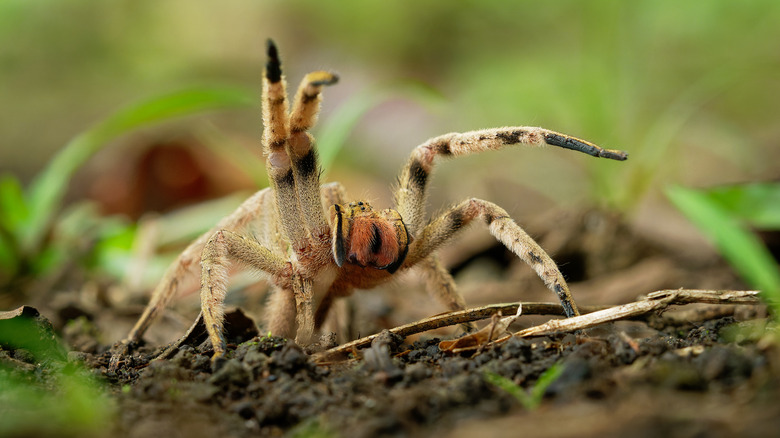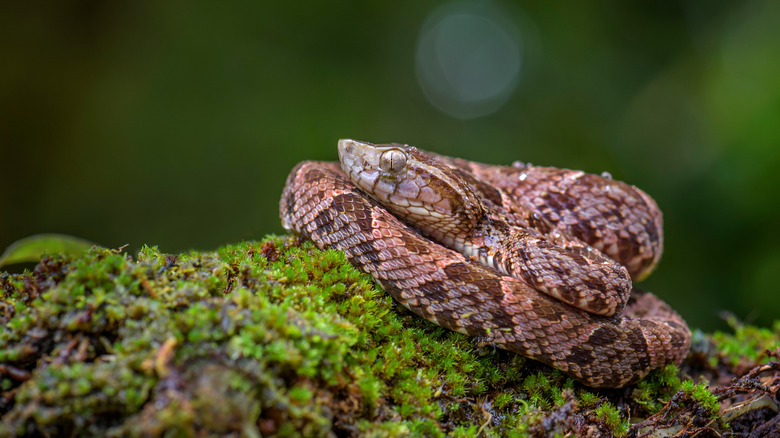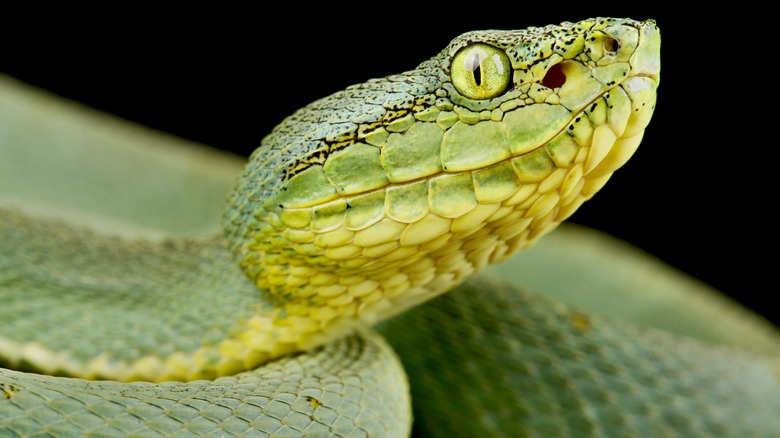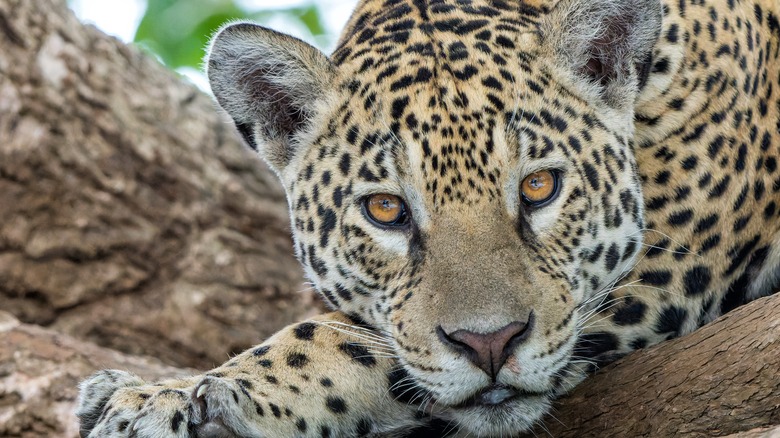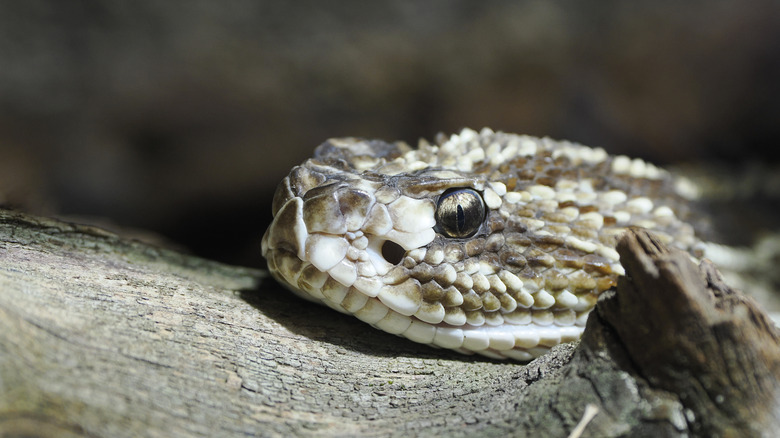Dangerous Animals You Wouldn't Want To See In The Amazon Rainforest
The largest rainforest in the world is a place that generates superlatives. It spreads millions of square miles across South America, bleeding into eight countries, and is more than half the size of the Lower 48 — yes, you read that right! Billions of climate-change-combatting trees and hundreds of indigenous tribes live in the rainforest, and in addition to the sizable population of humans that call it home, the Amazon is where you can encounter a treasure trove of plants and animals.
Some estimates suggest that 10% of all species on the planet are found here, with new ones regularly discovered every year. Much of what visitors encounter is harmless — from tiny insects to the larger capybara, which looks like an oversized, sand-colored guinea pig. With its stocky torso and squat legs, it is undeniably cute. Yet, there are other creatures in the forest that travelers should make an effort to avoid, animals that may look sweet and innocuous but could leave visitors writhing in agony.
Amazonian bushmaster
The highly venomous snake, also known as the South American bushmaster, generally grows to about 6 feet. With black triangles patterned over its brown skin, it has a bold appearance. These reptiles are rarely seen, often living alone in forests and plantations, coiled on the ground, sometimes in plain sight, other times camouflaged among leaves and vegetation, or hiding in crags and rocks when not hunting.
Humans tend not to excite them; they usually stay coiled or wriggle away in the brush, but they can just as easily spring to defense and attack, sinking their fangs in before injecting venom. That venom can stop blood from clotting and can cause severe pain, bleeding, vomiting, loss of consciousness, respiratory difficulties, diarrhea, secondary infections, and even death. Typically, these snakes will eat small creatures like rats, squirrels, and porcupines, as well as monkeys and birds, while some indigenous tribes in the rainforest will eat them.
Amazonian giant centipede
More than 100 species of the Scolopendra giant centipede exist around the globe, from the forests of Australia and Asia to spots in the Caribbean and South America. What they all share is that they are frightening to look at and are ruthless killing machines. The largest lives in the Amazon, the Scolopendra gigantea, often called the Amazonian giant centipede. With a seemingly impenetrable outer shell, length of up to a foot, and a wiggling method of movement that makes them hard to track — not to mention the huge number of little feet that shuffle it along — it just looks scary.
It uses those feet to shoot toxic venom into the nerve centers of its prey, small animals that include bats, snakes, and even birds. The giant centipedes are just as comfortable in the water as they are hanging off the roof of a bat cave, and while they rarely kill people, their bites definitely will hurt, causing swelling and sharp pain. Look out for them in areas of damp undergrowth, among leaves on the ground, or in rotting wood. Better yet, don't look for them at all.
Assassin bugs
These super light insects often are brightly colored, a combination of hues that might make an onlooker gaze at them in wonder. Sometimes painted in reds, greens, and oranges, but frequently a simple black or gray, they are tiny, sometimes as small as a fingernail. Yet, don't let their miniature stature fool you; they get their name from their quick killing skills, using efficiency to capture and devour their prey. They kill small insects effortlessly, using saliva emitted from a curling, sharp-tipped proboscis to break down their victims.
Found in many locations around the globe, they tend to congregate in areas of greenery, such as fields and expanses of grass, as well as here in the Amazon. They generally do not pose a danger to humans directly on account of their bite, although they have been known to feast on human blood, especially around the eyes and lips. However, they can transmit diseases through their saliva, which is why travelers should avoid them.
Black caiman
In the United States, crocodiles and alligators are to be dodged at all costs, and in the Amazon, the same is true for the black caiman. A huge animal with a buffet-ready appetite, these amphibious creatures can eat deer and cows with consummate ease. Much like their reptilian kin, caimans like to lounge in the sun to warm themselves and can stay motionless for what seems like an eternity. But when it comes time to feed, these creatures, which can weigh a tonne and grow to more than 15 feet, have no competitor.
They are the top predator in the Amazon, and even jaguars are rarely a match for them. Caimans are extremely territorial, especially if there are eggs in their nest, and will take any advance toward them as a threat. They tend to be most active at night, when they hunt, and can quickly make a meal out of horses, otters, snakes, armadillos, and even humans if they so feel inclined.
Brazilian wandering spider
The genus that this spider is part of gives a hint of the deadliness of this tiny terror — "Phoneutria" is Greek for "murderess." This spider's venom is potent and can be fatal for humans. Nine species of the Brazilian wandering spider live in the Amazon, and all are nocturnal. They have sizable bodies, a couple of inches across, long, slender legs, and their gray or brown exteriors are covered in a layer of hair. Unlike many spiders, they don't weave intricate webs but roam the forest ground, silently seeking out prey.
Their method of attack can be direct and quick or slow and subtle through ambush, and their food includes reptiles, mice, and other spiders. They generally only use up all their venom out of defense, not for attack (only small amounts are used to slow prey), and such neurotoxin venom will cause a burning sensation around the bite in humans. What might follow are sweats, changes in blood pressure and heartbeat, nausea, impaired vision, convulsions, and, in men, an enduring erection, which is far more painful than you might think.
Bullet ant
The name of this ant doesn't refer to its compact, ruthless power but rather the sensation that a sting produces. Though the ant is only about an inch in length, its fierce bite feels like a shot to the skin, and a handful of these insects can easily overpower a human with that kind of pain. It's not the ferocity or size of the injection that is the most harmful aspect of a bullet ant attack, but the composition of the sting itself.
The stinger, a tiny sliver that is around 2 millimeters in length, is filled with a neurotoxin that makes the prick intensely painful, really like a bullet, with that burning, searing torment lasting for many hours. It sounds like the worst possible torture, and it is, but for the indigenous Sateré-Mawé, it's part of growing up. For boys to graduate into full warriors, they must endure repeated stinging by these ants on their hands over a protracted period of time.
Bull shark
This active predator is found throughout the waters of the world, from shallow estuaries to deep tropical oceans, but it can also live in freshwater. They are found in parts of the Amazon in Peru and are distinguished by their snub nose, can grow to a monstrous 13 feet, and weigh more than 600 pounds. What makes them even more fearsome is their inherent nature, one of aggression, with attacks on humans not uncommon.
While they tend to feed on fish, birds, turtles, and marine mammals, they don't discriminate when it comes to dinner time. Bull sharks don't have strong vision and use smell and electric impulses to hunt. That leads them to easily misinterpret people in the water as being common prey, and they might attempt an exploratory bite to figure out what tasty morsel awaits before chowing down on you as a main course. They might leave you alone after the bite, tastes differ after all, but a big bite can lead to massive blood loss and death.
Common lancehead
A viper found is many parts of Ecuador's Amazon, this reptile with a triangular head and brown skin is deadly. It lives in forests and fields, sometimes boldly venturing into homes, and prefers to be near water sources. They are idle by day, clumped under trees or shrubs, and start to move around sunset, picking their spots for ambushing prey. Sharp fangs are used to cut into their targets, injecting them with venom, and the snake will then wait for the prey to give up, or if they try to flee, follow their scent to the weakening prey.
Rodents, lizards, and even fish are all part of the diet, but these snakes will also regularly down animals much larger than them. Humans won't automatically die from a bite but can expect to experience intense pain, lots of bleeding, swelling, infections, loss of consciousness, and tissue damage. Death is a slim possibility, but a possibility nonetheless.
Electric eel
This slithering fish sometimes hunts in packs and shocks victims into submission. Eels are nocturnal and are unlikely to be seen during the hours of daylight, resting at the bottom of the river, waiting for darkness to fall. They have bad eyesight but use small bursts of electricity to find their way around the murky depths. When they find prey, a more powerful charge will stun the victim (this shock is also one method to ensure predators back off).
The voltage of these shocks is monstrous, more than five times that coming out of a wall socket in the U.S., and is powerful enough to kill a human. But such instances are rare, and these creatures prefer to mind their own business, attacking only when looking to feed — their usual food source is fish — or for defense. It has been found that eels will gather to attack en masse, shepherding large groups of fish into an area before leading an onslaught.
Goliath birdeater
The largest spider you are ever likely to see, the Goliath birdeater is a sly, shrewd hunter found in the forests of South America. They can live up to 20 years, with a leg span of a foot, and they have a diet that can be described as "eat anything." A type of tarantula, the Goliath birdeater's name is misleading since birds aren't its main dietary intake. They certainly are capable of eating one, but they are more known for their food sources of frogs and rodents.
It uses fangs to inject venom into its prey, knocking them out before slowly killing them, pulling the animal back to its lair, and eating them from the inside out. The spider also has a crack defense system, with small, sharp hairs that can launch onto predators to deter them. Their bites aren't disastrous for humans, but they are definitely irritating, like the sting of a bee or wasp.
Green anaconda
This snake is also a big one, growing to 12 inches across and 30 feet in length, with weight pushing past 500 pounds. These attractive animals have a classic, exotic serpent aesthetic — think smooth olive and brown skin pocked with black and yellow blotches. Anacondas don't have deadly poison in their fangs but instead use their immense weight, flexibility, and sinewy muscle power to overcome prey. They will mercilessly grip, twist, and suffocate victims.
That's not to say that their teeth are useless; coupled with the jaws, they are instrumental in the killing process, gripping onto prey while they wrap the rest of their torso around the hapless creature. Death occurs when the snake crushes the breath and life out of the target or pulls it underwater to drown. Anacondas are languid on the ground, but underwater, they are agile. They may hang on trees and drop onto prey or wait by rivers waiting to strike, nabbing meals like deer, capybara, birds, and even caiman. The reptiles open their jaws almost incomprehensibly wide and swallow prey whole.
Green jararaca
A type of pit viper, notable for its two tones — a leafy green top and sunny yellow bottom — this snake isn't large, but it sure packs a punch. The green jararaca is found at lower elevations and typically masses in forests near water, rarely staying more than a few feet above the ground. They grow to about 2 feet in length, sometimes a bit longer, and their relatively small size makes them nimble and efficient navigators around the Amazon.
By day, they rest among the foliage, often in the shade around palm trees, their tales slung around branches or trunks. At night, when temperatures fall, they can use thermal sensors to detect the heat of prey. Food includes small birds, mice, frogs, and rabbits, while its toxic bite can lead to severe bleeding (the venom has anti-coagulating properties), headaches, irreversible tissue damage, loss of consciousness, and sometimes death in humans.
Harpy eagle
The faces of these birds might look funny, but the powerful creatures are no laughing matter. The head is the most arresting sight, appearing like a cross between a traditional eagle's sharp, curved beak and almond-shaped eyes and the friendly, fluffy roundness of an owl. Don't let the mask fool you, for the harpy eagle is a keen hunter whose mighty claws help it capture prey like monkeys, rodents, and armadillos. Females are larger in size and can grow to 20 pounds in weight, with a wingspan of more than 7 feet.
More terrifying is the size of those talons, 5 inches in length and capable of ripping a nasty hole in any flesh. Once captured, they carry their prey to the treetops, away from prying eyes, to devour. While deforestation and loss of habitat have made this a somewhat endangered species, and you might not see them on a trip to the Amazon, be aware of the devastation they can cause with one speedy swipe of a claw.
Jaguar
The biggest cat in the forest and the Americas, the jaguar is an intense hunter. One of the most powerful creatures in the Amazon, it's also one of the most elusive. Wary of strangers, jaguars are threatened by poaching and diminishing terrain caused by deforestation and agricultural development of the rainforest. The population of these speckled creatures has plummeted by 50% in the last century, and visitors will be extremely lucky to spot one on a trip to the rainforest. But, if you do see one, keep your distance.
They hunt on the spur of the moment, eating what they find rather than planning and staking their prey — typical food includes deer, capybara, birds, monkeys, and fish (they are seasoned swimmers) — and are awake at night and by day. It's a jaguar's bite that is deadly, exerting enough pressure that it can puncture the tough skin of a caiman or a turtle's shell. For larger creatures, a bite at the back of the skull is the killer blow.
Mosquitoes
We've all wondered what the point of mosquitoes is, and what purpose they serve except to make our lives miserable. These lightweight bloodsuckers, however, are essential in the food chain, with the larvae acting as feed for fish and birds and adults being consumed by frogs, birds, and other insect species. Some mosquitoes are also pollinators of flowers, uninterested in human blood as they flitter and flutter. And yet, none of that really forgives the itching they cause, does it?
And don't get us started on the ones in the Amazon, which not only produce itchy welts but also transmit malaria, dengue, and yellow fever, all of which can be deadly. The environment in the Amazon is amazing to see, but it's perfectly suited for mosquito breeding, with still and slow-moving bodies of water ubiquitous and warm temperatures ideal for the rapid multiplication of those pesky pests. Bring bug spray and plenty of it.
Red-bellied piranha
All piranhas are not the same, and of the 20 or so species that live in the Amazon, many pose no danger to humans. Visitors can happily swim in lakes where these fish roam without fear of a toenail being nibbled off. You might even have piranhas swim by and brush against you without noticing. But one piranha in particular isn't quite as pacifist-leaning, and that is the red-bellied piranha. Named for their fiery-hued undercoat, they can grow to more than a foot in length and weigh up to 7 pounds.
They gnaw away at crabs, fish, and lizards, though not exclusively so, and can attack a young caiman, attacking in large groups to nip, bite, and chew an animal to death, literally. Their teeth are extremely sharp, and indigenous tribes have been known to use them as cutting tools and as weapons. if you dip your finger into the water at the wrong time, that digit can be gone in an instant.
Poison dart frog
By some estimates, there are scores of frog species in the Amazon, but one type poses the greatest danger. With small bodies that seem to glisten with perspiration and wild Day-Glo colors that look lifted from a hallucinogenic episode, the poison dart frog seems like a little cutie. But these tiny terrors, which live in trees or on the ground, are brightly colored to keep others away, not as a means of attraction.
The poison that seeps out of their skin will paralyze a small animal. A small amount of it can actually kill a human. Luckily, a frog won't ever emit enough poison in its daily cycle to kill a person, but the potency of that poison certainly gives pause for thought. Some indigenous tribes gather enough of it to coat on darts they use for hunting, which is where the frog gets its name.
South American rattlesnake
A type of pit viper scattered across the continent that gives it its name, this rattlesnake can thrive in grasslands, dry habitats, and forests and often lives alone, not part of a larger gathering. Dusk and mornings are when these snakes tend to move around, and their bite can be extremely dangerous, though generally, they aren't bothered by humans, opting to usually ignore them or raise their heads in the face of an obvious or immediate threat.
The South American rattlesnake eats mostly rodents, the easiest and most common food source in its environments. If it does bite a human, the victim can expect a host of symptoms, none of which sound like much fun. These include hearing issues, loss of muscle function (including the neck), partial loss of vision or even total blindness, failure of the kidneys, and breathing problems that can be fatal. Avoid the South American rattlesnake at all costs, although that should go without saying.





